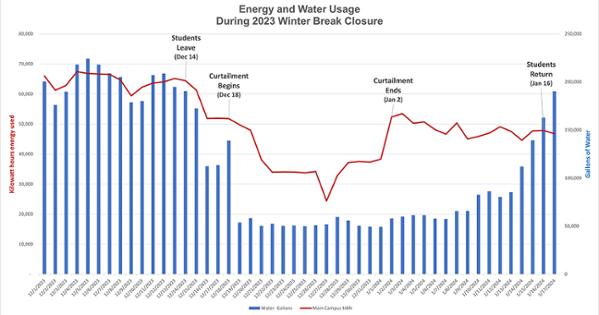Winter Energy Curtailment Efforts Result in Significant Energy and Water Cost Savings

The measurements all have been collected and analyzed and the findings make apparent that American University’s annual Winter Energy Curtailment efforts were again an overwhelming success.
In fact, the two-week shutdown of campus for the holidays this past December helped AU save:
- 77,000 gallons of water
- 2.58 billion Btu’s of energy (gas & electric)
- 205 metric tons in Carbon emissions (or taking 44 cars off the road for a year)
Overall, AU saw an energy cost reduction of $77,537.
The annual curtailment effort, led by Facilities Management, was made possible through the enthusiastic collaboration, participation, and continued support of the entire university community, including but not limited to students, faculty, staff, and Housing and Residence Life. The community’s cooperation has been the cornerstone of our continued success with winter energy curtailment.
“We were able to reap significant environmental and financial benefits by working together to simply lower thermostats to 55°F, turn off all non-critical lighting, unplug non-critical equipment and appliances, close all windows and doors, and take other common-sense, energy-conserving actions,” said David Osborne, Director of Energy & Engineering.
Main Campus Electric Energy

To measure the effectiveness and success of the Winter Holiday Curtailment efforts, the Energy and Engineering team analyzed energy reduction through various sources. Using Atrius, an energy dashboard platform, the team was able to graph total energy consumption and generate heat maps that provide insight on energy usage in the various buildings to help improve Heating, Ventilation, and Air Conditioning (HVAC) system efficiency and performance.
“Atrius displays output energy usage in 15-minute intervals to give users and viewers an overview of the energy consumption, and the heat map is one of the most powerful visual tools for tracking energy performance,” said Osborne.
Roper Hall Heat Map

Main Campus Water Usage
“Our ability to track and report on water consumption also shows how we can collectively impact and reduce our water usage. This metric will support identification of areas to improve water consumption efficiency as well as the impact of any efficiency improvements,” said Juan Allen, Energy Conservation and Efficiency Manager.
In the 13 years since AU began the all-hands Winter Energy Curtailment initiative, the university community’s efforts have proven to be a particularly effective way to help reduce energy consumption and overall carbon emissions. To date, the collaborative effort has resulted in an overall CO2 reduction of 2,709 metric tons and saved the university $838,550 in energy cost.
“The total savings resulting from our Winter Energy Curtailment over the span of more than a dozen years is equivalent to greenhouse gas emissions 7,452,236 miles driven by an average gasoline-powered vehicle,” said Allen.
